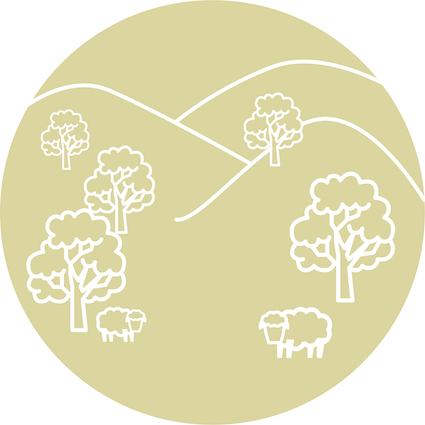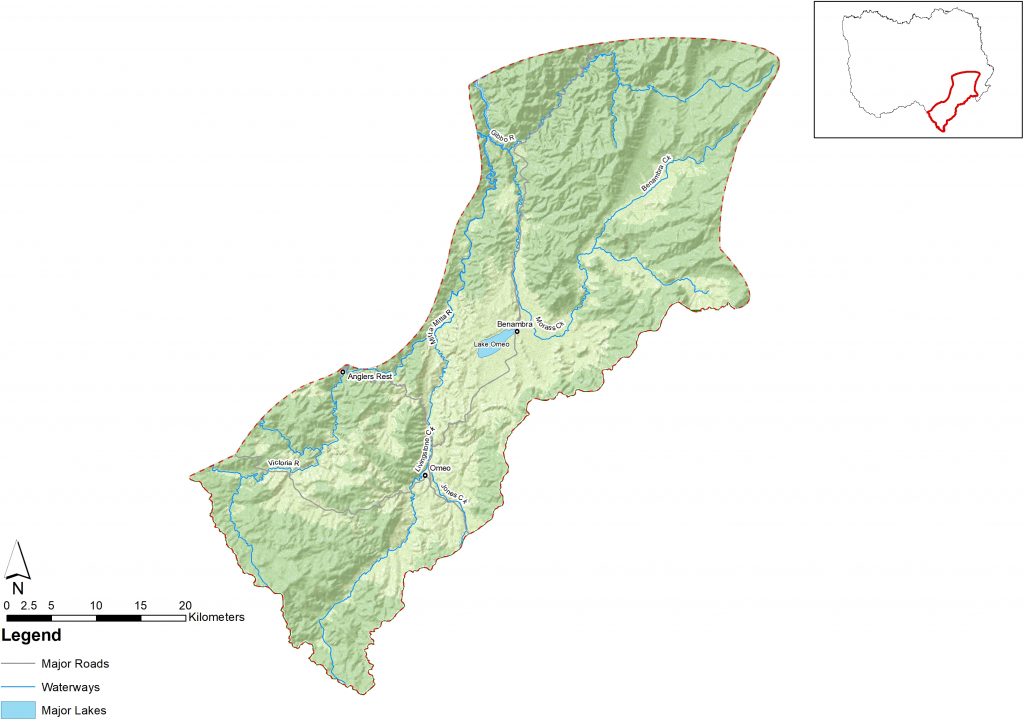
Vision
Locally supported and connected communities stewarding the environment alongside sustainable agriculture and recreation
Introduction
An area that features valleys surrounded by forested mountains. The area is a hotspot for recreational fishing, camping and water sports and supports large grazing operations around Omeo and Benambra.
Unlike other areas in north east Victoria, this landscape has a social gravity linked with Gippsland. The area has an ageing population, is experiencing population decline and has low economic diversity with a high dependence on agriculture.
The main regional town is Omeo, with many other small towns and localities, such as Benambra, across the landscape.

What is important?
Important attributes
Important attributes of this landscape identified by those who live, work, visit or connect with this landscape include:
- Significant to Traditional Owners/First Nations Peoples as a place of ceremony and food resource collection in certain seasons
- Remoteness, quiet lifestyle and breathtaking scenery
- Large sections of farmland with grazing operations, notably sheep and cattle production
- Clean, unregulated and wild rivers
- Natural, undeveloped spaces for recreational activities (e.g., Skiing, fishing, kayaking, rafting, bushwalking, horse riding, swimming, camping)
- Settler history sites reflecting pioneer settler, gold mining and cattlemen past.
Key features
| Theme | Key features |
|---|---|
| Land | This landscape consists of extensive mountain valleys and comprises mostly of freehold land, with public land at higher forested elevations and alpine regions. Rolling mountains rise above vast open valleys offering spectacular views. Valley floors are rich in fertile soils. Basalt flows characterise the cliffs of the Morass Gorge. The geology, geomorphology and soils of this landscape are diverse, ranging from the mountains to the agricultural plains in the south around Omeo and Benambra, mostly for grazing operations. Cattle and sheep production is the most widespread form of agricultural land use. |
| Water | Priority waterways include Victoria River, Mitta Mitta River (heritage listed) and Gibbo River. Important creek systems are Spring Creek, Morass Creek, Benambra Creek, Buenba Creek, Livingstone Creek and Jones Creek. The Morass, Hinnomunjie swamp and Lake Omeo are important wetlands within this region. |
| Biodiversity | Iconic features across this landscape include views of alps and forests, and high valued riparian and aquatic habitat that provides home to many significant and threatened species. Some important species and communities: Flora Hairy anchor plant (Discaria pubescens) Enigmatic greenhood (Pterostylis aenigma) Terrestrial fauna Spotted tree frog (Litoria spenceri) Brush-tailed rock-wallaby (Petrogale penicillate) Glossy grass skink (Pseudemoia rawlinsoni) Aquatic/riparian/wetland fauna Platypus (Ornithorhynchus anatinus) Macquarie perch (Macquaria australasica) Trout cod (Maccullochella macquariensis) Brown Trout (Salmo trutta) White-bellied sea eagle (Haliaeetus leucogaster) |
| Community | The main regional town is Omeo, along with the grazing district of Benambra. Social gravity is linked to Omeo within the landscape and Bairnsdale acting as the nearest urban service centre in East Gippsland. Lifestyle is predominantly associated with natural environment appreciation and rural living connected to the local agriculture. The Upper Mitta Mitta River is a high value recreational area for fishing, camping and water sports – with some of the best brown trout (Salmo trutta) fishing and rafting waters in Victoria. Community involvement in the system is strong, but somewhat limited due to the dynamics of the demographic and dispersed populations. Wilderness and remoteness are valued by the community. Stakeholders described this value as ‘unspoiled, far enough from city, pristine, minimal development and isolation’. Low economic diversity, with high dependence on agriculture. This landscape is culturally significant for Traditional Owners/First Nations Peoples with remnants of scar trees and artefacts scattered waterways. |
Condition
The following is a snapshot of condition for the Southern Mountain Landscape.
| Land | The Omeo/Benambra region is the most severely gully eroded area in the Lake Hume catchment. Steeper slopes in the catchment are prone to water erosion, particularly sheet and gully erosion. This tends to be caused by high intensity rainfall on land with limited groundcover vegetation. Over grazing by stock, rabbits as well as burning has led to a loss of groundcover vegetation in the agricultural areas of this landscape. High rainfall events are more likely to occur in late summer and autumn when groundcover vegetation is the most limited. Soil health issues include soil structure decline, organic matter loss and acidic soils. Soil carbon stocks are generally steady with potential for increases under current or altered land management. |
| Water | The summer base flows in some of the tributaries such as Livingstone Creek are reduced due to urban and rural demands. All of the waters in the system flow into Lake Dartmouth and are stored for release into the Lower Mitta Mitta System and Lake Hume. Most waterway systems are classified as being in good condition, however, Jones Creek is rated as poor. Buenba Creek is considered in excellent condition[46] Agricultural run-off impacts the quality of waterways in this landscape. The hydrology of the system is relatively intact, with persistent base flows from alpine and forested landscapes. The Upper Mitta Mitta catchment is part of the Lake Hume Special Water Supply Catchment, recognised for the considerable quantities of water supplied for downstream users. The quantity and reliability of water resources in the system support agricultural production systems, mainly grazing. In-stream woody habitat is considered as severely depleted (greater than 80% decrease of natural vegetation in Morass Creek, Benambra Creek and in the lower reaches of Livingston Creek.[47] |
| Biodiversity | The condition of vegetation varies greatly from being largely unfragmented in higher elevations and alpine environments, to highly modified areas of agricultural land. The hairy anchor plant (Discaria pubescens) is a threatened species once widespread in north east Victoria. The species was formerly known in the Wodonga and Mitta Mitta areas, but is now restricted to fragmented populations in the Benambra area. The enigmatic greenhood (Pterostylis aenigma) is a rare and nationally endangered species. The single population occurs within the Alpine National Park, about 10 km north of Omeo. With a small population of fewer than 100 plants, the species is particularly at risk. Draining of The Morass, weed invasion, intensive grazing, extensive clearing for agriculture and mining across this area has reduced biodiversity values significantly. In some areas, native flora and fauna is threatened by invasive weeds (e.g. English Broom, willows, blackberries) and pest animals such as deer, feral horses and pigs. |
| Community | Largely dependent upon agriculture, however, investment in mountain bike trails likely to bolster a growing tourism industry. Low economic diversity and is subject to structural ageing and population decline. Strong community involvement in NRM, but somewhat limited due to the dynamics of the demographic and dispersed populations. Communities are somewhat remote and isolated. The separation of these communities has been forged by the barriers of mountain ranges, i.e., the Alpine National Park between Omeo and the Upper Murray. The Omeo valley has a high proportion of unoccupied dwellings. Rather than being a sign of weekender activity, this may be a legacy of the 1990s Kennett-era policy of enhancing agricultural adjustment in the valley through targeted property amalgamation. Historically there were cultural links between some of the communities across the ranges forged by the shared task of cattle mustering on the High Plains. These links no longer exist or are transformed by a shared stake in the ski industry. Dominated by farms to the value of $200k-$250k as measured by Estimated Value of Agricultural Operations (EVAO). |
What is changing?
The world and our region are changing rapidly and north east Victoria is more interconnected across multiple spatial scales than ever before. This section describes the major drivers of change and what this means for the Southern Mountain landscape.
Drivers of change
| Driver of change | Leading to |
|---|---|
| Increase in visitation and recreational use of natural areas | Pressures from recreation and tourism on waterways and environment, including littering and spread of weeds. Increase in investments in town and land prices. Increase conflicts around river access laws – insufficient regulation and enforcement to prevent illegal camping on private land. Opportunities to diversify economy and develop strength in industries outside of agriculture. |
| Invasive pest plants and animals, including introduced aquatic fauna, and weeds | Increase in numbers of environmental weeds on agricultural lands and waterways, such as broom (Cytisus scoparius) and willows (Salix spp.) in the Upper Mitta Mitta River. Increase in numbers and distribution of pigs, deer, and feral cats. Spread of diseases threatening native species, e.g., wombat mange. Competition for resources, leading to increased pressures on native species. The community is concerned about the health of wombat populations and the decrease in platypus numbers. |
| Ageing and declining human population | Ageing and decline of local population leads to a decrease of active NRM – including the adequate management of private land and volunteering groups, e.g., older generations have reduced capacity to engage in weed and pest control activities. Loss of local and intergenerational agricultural knowledge. Loss of local management and ownership, which is aggravated by the lack of succession planning – leading to local disempowerment. Disconnection ofTraditional Owners/First Nations groups. Remoteness of the community – geographic isolation has fostered some degree of self-reliance. |
| Climate change and acute shocks and extreme events | Increase in severity and frequency of extreme events will continue to impact water quality, biodiversity and communities. Declining average rainfall and change in seasonal patterns, leading to less snow and lower water levels in local creeks. This impacts on agriculture, ski activities in Alpine areas, and native fauna and flora. The increased frequency of extreme events leads to less time for environmental recovery and regeneration, including waterway health and water quality. Bushfires are having major impacts and the resilience of local communities is being tested – it is possible that bushfire effects (increased frequency and severity) will result in some people leaving the region and moving to more closely settled areas and/or retirement. |
| Changing land use | Reduction in quality and quantity of paddock trees (habitat). Changing surrounding land use is impacting on farmers’ social license to operate and on cultural, biodiversity and amenity values. Increased ‘tree change’ migration is seeing an increased interest in sustainable land management. Increasing interest in recreational access to waterways and connectivity between rail trails. Mining operations in or near this landscape have the potential to contribute to its economy. Community holds varying views on the matter, with concerns around contamination of local waterways and long-term environmental impacts. |
Outcomes and priority directions
Key outcomes and priority directions for the RCS have been developed drawing on information and discussions with people who live, work, visit and connect with north east Victoria at a regional and local-scale.
Outcomes and their associated priority directions that are important to the Southern Mountains landscape from the regional themes of biodiversity, water, land and community include:
Biodiversity
- By 2040, an increase in the extent (ha) and connectivity of native vegetation across north east Victoria.
- By 2040, an increase in the area of natural environments protected and remnant vegetation enhanced.
- By 2040, improved trajectories for priority native icon, threatened and culturally significant species and ecological communities’ (priority species and communities).
- By 2040, an increase in the understanding and focus on supporting resilient biodiversity in a changing climate.
Land
- By 2040, land management practices are culturally appropriate reflecting Traditional Owners/First Nations Peoples aspirations.
- By 2040 community resilience and land management practices are continually adapting to accommodate challenges of climate change and extreme events.
Community
- By 2040, an increase in the number and diversity of individuals and organisations supporting Landcare and community NRM groups in north east Victoria.
- By 2040, an increase in participation by visitors and absentee landholders caring for, and stewarding the natural environment across north east Victoria.
- By 2040, there is an increased diversity of investment in NRM in north east Victoria.
- By 2040, Traditional Owners/First Nations Peoples’ knowledge and practice is healing, adapted to a contemporary context and applied to both heal and care for Country.
Water
- By 2040, waterways are healthy and well managed thereby protecting waterway-dependent iconic, culturally important and threatened (priority species) species.
- By 2040, there is improved protection of water quality and waterway/wetland/floodplain system values during and following extreme events.


